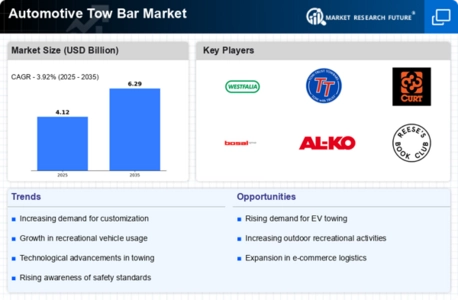Rising Vehicle Ownership Rates
The Automotive Tow Bar Market is poised for growth due to the rising vehicle ownership rates across various regions. As more individuals acquire vehicles, the demand for towing solutions is expected to increase correspondingly. In 2025, vehicle ownership is projected to rise by approximately 4 percent, particularly in emerging markets where urbanization and disposable income levels are on the rise. This trend is likely to drive the need for tow bars as consumers seek to enhance the utility of their vehicles. Additionally, the growing trend of multi-vehicle households further contributes to the demand for versatile towing solutions, thereby reinforcing the Automotive Tow Bar Market's growth trajectory.
Growth of E-commerce and Online Retail
The Automotive Tow Bar Market is significantly influenced by the growth of e-commerce and online retail platforms. As consumers increasingly prefer the convenience of online shopping, the accessibility of towing solutions has improved markedly. In 2025, it is estimated that online sales of automotive accessories, including tow bars, will account for a substantial portion of the market, potentially reaching 30 percent. This shift not only broadens the consumer base but also encourages manufacturers to adopt digital marketing strategies to enhance visibility and reach. Furthermore, the competitive landscape is evolving, with new entrants leveraging online platforms to offer innovative towing solutions, thereby intensifying competition within the Automotive Tow Bar Market.
Increasing Demand for Towing Solutions
The Automotive Tow Bar Market experiences a notable surge in demand for towing solutions, driven by the rising popularity of outdoor recreational activities. As more consumers engage in camping, boating, and other leisure pursuits, the need for reliable towing equipment becomes paramount. In 2025, the market is projected to witness a growth rate of approximately 5.2 percent, reflecting the increasing consumer inclination towards vehicles equipped with towing capabilities. This trend is further supported by the expansion of the recreational vehicle sector, which has seen a significant uptick in sales. Consequently, manufacturers are compelled to innovate and enhance their product offerings to meet the evolving needs of consumers, thereby propelling the Automotive Tow Bar Market forward.
Regulatory Compliance and Safety Standards
The Automotive Tow Bar Market is significantly impacted by regulatory compliance and safety standards. Governments worldwide are increasingly implementing stringent regulations to ensure the safety and reliability of towing equipment. In 2025, it is expected that compliance with these regulations will become a critical factor for manufacturers aiming to maintain market share. This trend compels companies to invest in quality assurance and testing processes, thereby enhancing product reliability. Furthermore, as consumers become more aware of safety issues related to towing, the demand for certified and compliant tow bars is likely to rise. Consequently, adherence to safety standards will not only influence purchasing decisions but also shape the competitive landscape of the Automotive Tow Bar Market.
Technological Innovations in Tow Bar Design
Technological innovations play a crucial role in shaping the Automotive Tow Bar Market. Advances in materials and engineering have led to the development of lighter, stronger, and more efficient tow bars. In 2025, it is anticipated that the introduction of smart towing solutions, which integrate with vehicle systems for enhanced safety and performance, will gain traction. These innovations not only improve the user experience but also address safety concerns associated with towing. As manufacturers invest in research and development to create cutting-edge products, the Automotive Tow Bar Market is likely to witness a transformation, attracting tech-savvy consumers who prioritize advanced features in their towing solutions.



.webp)
.webp)
.webp)
.webp)
.webp)
.webp)








Leave a Comment